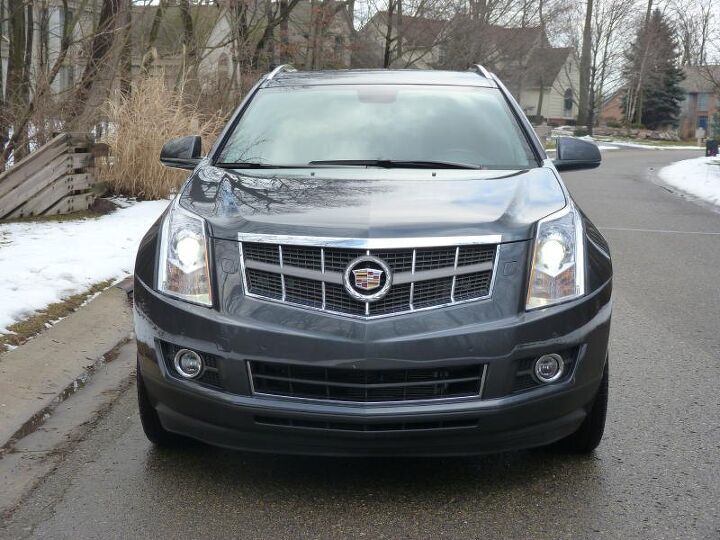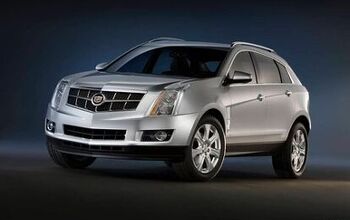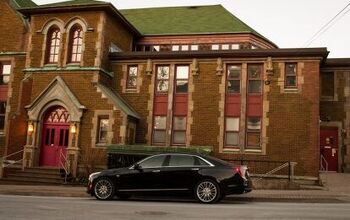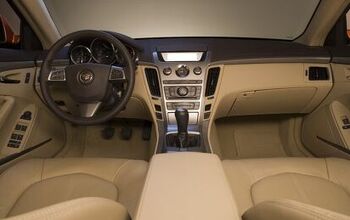Review: 2012 Cadillac SRX 3.6
Large organizations are prone to overly simplistic thinking. It’s just too hard to communicate anything complicated or nuanced to all involved. One overly simple idea: reduce the size of the engine, and fuel economy will improve. Need a performance variant? Shrink the engine a little more and add a turbo. The actual result in the case of the Cadillac SRX: a base engine with too little torque and an optional engine for which GM charged $3,820—to provide performance similar to everyone else’s base engines. For 2012, the SRX receives a solution that was obvious from the start: the corporate 3.6-liter V6 replaces last year’s 3.0-liter. The turbocharged 2.8 is gone. And?
With the new 308-horsepower engine (up from 265 for the 3.0 and 295 for the 2.8T), the Cadillac edges even closer to the class norm. The Lexus RX 350 has a 275–horsepower 3.5-liter V6. The Lincoln MKX a 305-horspower 3.7. The Acura MDX a 300–horsepower 3.7. The others are all within 150 pounds of Cadillac (the Lexus a little lower, the Lincoln and Acura a little higher). All have six-speed automatic transmissions and all-wheel-drive systems that engage when the front wheels slip (the Acura’s system in a more proactive manner than the others). So straight line performance is similar.
Braking, not so much. The Cadillac might stop as well as the others (I didn’t measure this) but its brakes require an unusually large amount of force. At a BMW comparison drive I attended about a year ago, the organizers felt the need to warn all participants about the SRX’s brakes. On the other hand, if you like a very firm brake pedal, the Cadillac delivers.
Dimensionally all four luxury crossovers are again similar, and so all are similarly larger and bulkier than the relatively spry Audi Q5, BMW X3, and Volvo XC60. The Cadillac feels especially solid and has the most tightly damped suspension of the bunch, but still manages to feel larger and bulkier than it actually is thanks to numb steering and a distant windshield. If it’s any more fun to drive than the others this is strictly relative. Of course, Cadillac tried catering to driving enthusiasts with the original SRX, and it sold poorly. The current one, with its much more mainstream (i.e. Lexus RX-like) configuration, is selling far better.
In terms of interior dimensions, the Cadillac doesn’t quite measure up, with a somewhat tighter rear seat and cargo area than the others. The Acura is the champ here, with a wider cabin and a third-row seat (adults only in a pinch). But the Cadillac isn’t so far behind that these deficits are deal-killers. The front seat, which is a much higher priority for many buyers, feels fairly roomy. What it doesn’t feel: notably comfortable. The cushion is flat and firm, even hard. Among this year’s Cadillacs, only the upcoming XTS has the large, cosseting seats many people expect in a Cadillac.
My favorite feature in the Cadillac: a rear seat belt reminder that shows which of the three are in use and lights up a warning if any are undone while the car is still in motion. This feature is very useful if you have kids—no need to visually check whether they’ve buckled up. I expect to find it in more and more car models going forward. Perhaps even all of them, if car safety regulators get their way.
The tested SRX, the top trim with all-wheel-drive and optional dual-screen entertainment system, lists for $51,055. Compared to the Lincoln MKX, the Cadillac is priced within $500. Adjust for feature differences using TrueDelta’s car price comparison tool bumps the Cadillac’s advantage to $2,000 at MSRP, $1,100 at invoice (Cadillac dealers must work with especially miserly margins). The Lexus is the one both Cadillac and Lincoln are gunning for. When the RX 350 and SRX are both similarly loaded up, the Lexus costs about $3,000 more—at MSRP. Compare invoices, and they’re only about $400 apart because Lexus dealers enjoy much more generous margins. Adjust for remaining feature differences and the Cadillac’s price advantage grows by about $1,200. The Acura is priced a little higher than the Lexus. So the Cadillac is actually the least expensive. With the $3,820 2.8 turbo, it lost this important advantage. So in this respect the new 3.6-liter engine is very successful.
The rear seat belt reminder doesn’t turn you on? Going over the specs and features, now that the weak base engine is history nothing else stands out, positively or negatively? Why, then, pick the Cadillac over the others? One word: styling. The Acura, Lexus, and Lincoln are nothing special to look at. The last still looks a bit much like…a Ford. The Cadillac, with its chunky styling and aggressive stance (with the must-have 20-inch wheels), looks nothing like the others and nothing like a Chevrolet, either. Instead, it appears crisp and upscale, especially in “gray flannel metallic,” vying with the second-generation CTS as the best realization of the marque’s polarizing art-and-science design language. You might not like it, but you won’t mistake it for something else. Judging from sales, plenty of people do like it.
Cadillac provided the car with insurance and a tank of gas.
Michael Karesh operates TrueDelta.com, an online provider of car reliability and real-world fuel economy information.
Michael Karesh lives in West Bloomfield, Michigan, with his wife and three children. In 2003 he received a Ph.D. from the University of Chicago. While in Chicago he worked at the National Opinion Research Center, a leader in the field of survey research. For his doctoral thesis, he spent a year-and-a-half inside an automaker studying how and how well it understood consumers when developing new products. While pursuing the degree he taught consumer behavior and product development at Oakland University. Since 1999, he has contributed auto reviews to Epinions, where he is currently one of two people in charge of the autos section. Since earning the degree he has continued to care for his children (school, gymnastics, tae-kwan-do...) and write reviews for Epinions and, more recently, The Truth About Cars while developing TrueDelta, a vehicle reliability and price comparison site.
More by Michael Karesh
Latest Car Reviews
Read moreLatest Product Reviews
Read moreRecent Comments
- MaintenanceCosts What is the actual out-the-door price? Is it lower or higher than that of a G580?
- ToolGuy Supercharger > Turbocharger. (Who said this? Me, because it is the Truth.)I have been thinking of obtaining a newer truck to save on fuel expenses, so this one might be perfect.
- Zerofoo Calling Fisker a "small automaker" is a stretch. Fisker designed the car - Magna actually builds the thing.It would be more accurate to call Fisker a design house.
- ToolGuy Real estate, like cars: One of the keys (and fairly easy to do) is to know which purchase NOT to make. Let's see: 0.43 acre lot within shouting distance of $3-4 million homes. You paid $21.8M in 2021, but want me to pay $35M now? No, thank you. (The buyer who got it for $8.5M in 2020, different story, maybe possibly.) [Property taxes plus insurance equals $35K per month? I'm out right there lol.] Point being, you can do better for that money. (At least the schools are good? Nope lol.)If I bought a car company, I would want to buy Honda. Because other automakers have to get up and go to work to make things happen, but Honda can just nap away because they have the Power of Dreams working for them. They can just rest easy and coast to greatness. Shhhh don't wake them. Also don't alert their customers lol.
- Kwik_Shift_Pro4X Much nicer vehicles to choose from for those coins.













































Comments
Join the conversation
Nobody's mentioned the interior is thoroughly uncompetitive? The same color palette (including silver accents) is standard in the sub-$20k Hyundai Tucson. Now that I think about it, the same dash design too. I "get" crossovers. I also "get" Cadillacs, having owned a 1980 Eldorado and a 2002 STS. Have you ever been in the new Escalade? It's breathtaking, with wood and unashamed luxury (with probably the same level of tech). The CTS interiors leave me seriously disappointed. They look & feel like alternate-universe Acuras. Too much emphasis on tech and gray. Not enough on the depth of the experience. I would love the Cadillac of crossovers, I really would. It sucks that I have to step back a generation in SRX to get one.
I would buy this one ONLY if it had the Volt powertrain. Then it would be the ideal car in the market right now.